

Ceramic Wonder. How it's made. How It's Made Toilet. Pieces and Patterns: Complex Forms from Handbuilt and Wheel Thrown Parts. I find it rewarding and challenging to make pots people will use.
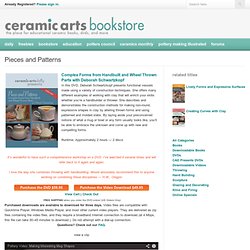
In my home growing up, hand made objects held special value. They were gestures of consideration and love. I continue to find objects a dwelling place for intention and association. The parameter of function both limits and frees me. Pottery basket part 2.
How to Make a Cool Textured Handle and Give it a Great Curve with a Dowel. How to Design, Make and Install Ceramic Tile Murals and Mosaics: Design Tips and How-To Instructions for Handmade Ceramic Tile Projects. Handmade ceramic tiles take advantage of all the complex possibilities of the ceramic process.
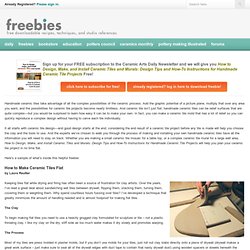
Add the graphic potential of a picture plane, multiply that over any area you want, and the possibilities for ceramic tile projects become nearly limitless. And ceramic tile isn’t just flat; handmade ceramic tiles can be relief surfaces that are quite complex—but you would be surprised to learn how easy it can be to make your own. In fact, you can make a ceramic tile mold that has a lot of relief so you can quickly reproduce a complex design without having to carve each tile individually. It all starts with ceramic tile design—and good design starts at the end; considering the end result of a ceramic tile project before any tile is made will help you choose the clay and the tools to use. And the experts we’ve chosen to walk you through the process of making and installing your own handmade ceramic tiles have all the information you will need to stay on track.
DVD – Beginning to Throw on the Potters Wheel with Robin Hopper. Beginning with wedging, Robin discusses the importance of finding a rhythm from the preparation of the clay to working on the wheel.
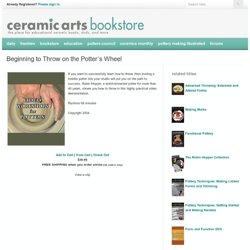
Many potters fail in their early attempts at throwing because they did a poor job of preparing the clay. Hopper then discusses the importance of the workspace and the tools you’ll need and their function. After wedging, centering is the next most critical stage. Many potters learn to center incorrectly, although some are successful in spite of their poor form—they just use a lot of energy and strain their joints. Robin demonstrates centering using brain instead of brawn, and gets you to actually throwing instead of spending many minutes watching your hands wobble around the wheel with a lump of off center clay. Robin next describes the process for creating cylinders since this form is the basis for almost every other form. Feathering vertical pottery. Google Traduction. 85. Preventing "S" Crack When Throwing off the Hump with Hsin-Chuen Lin. Nerikomi -ドロシーの練り込み マジック Dorothy Feibleman's Nerikomi Magic part 2. Google Traduction. Google Traduction. Video Nicolas Frize fait chanter la porcelaine - porcelaine, manufacture, instruments - videos Tribune Vidéos.
Manufacture - Vidéos - Tribune Vidéos. Pottery Video of the Week: How to Design and Make a Stiff Slab Vase. Mmp throwing The Wave. Lorna Fraser - Ceramics. Tantalizing Teapots. Pottery Video: Glaze Trailing Beautiful Surface Designs. Pottery Decorating Video:Five Fun Ways to Decorate Pottery with Slip. Handbuilt Pottery Making Video: How to Make a Properly Functioning Handbuilt Spout for a Teapot. Slab Roller Techniques and Tips: A Guide to Selecting a Slab Roller and Making Slab Pottery. Advanced Throwing Projects and Techniques. 7 Fun Ways to Decorate with Slips and Engobes - Boîte de réception - 'Yahoo! Mail' How to Attach a Generous Thrown Knob to a Lid Without Compromising Structure. Taking the Macho Out of Bigware (DVD) What If? Explorations with Texture and Soft Slabs. Handbuilding Nesting Bowls with Hump and Slump Molds. A few years ago, when I switched from cone 6 porcelain to low-fire earthenware, I was excited about the potential to work larger.
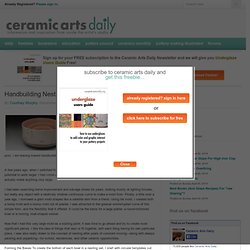
I had come up with some ideas, and even made some sketches, but had never actually made anything very large. Pottery Wheel Throwing in Cross Section. Lifting the Walls If all has been done correctly up to this point, you are at what is called the doughnut stage, ready to begin lifting the walls. Hold both hands as you would to shake hands with someone. Bring them together, and cross and lock your thumbs together, creating what we call the caliper position.
Bend your fingertips slightly inward. If you bend them too much you will rake clay off the surface, and if you bend them too little you will be working with the flats of your fingers and will have little control. Bend your hands/caliper downwards at the wrist. Throwing. Fusing: How to Make an Aralia Leaf Bowl. Pottery Making Illustrated. How to Throw a Large Porcelain Bowl Without Collapsing it. Enki Bilal working in his Studio. Vetrofusione. Clay Projects and Fundamentals. Pottery Video: Slab Building Architecturally Inspired Forms with Jeremy Randall. Peas Please: A Potter Talks About the Inspiration and Process Behind her “Sweet Pea” Vessels. Direct Waterjet, Inc - Broken Glass. How to make fused and slumped recycled glass - alocasia lamp. Pottery Video of the Week: How to Make an Elegant Wheel-thrown and Handbuilt Serving Tray. Block Printing Stamps – A No-Fire Way to Make a Great Impression. Click to enlarge My favorite pottery surface designs involve textures created by carving directly into a piece after it’s been formed.
Lately, as an alternative, I’ve been experimenting with carving my designs onto block printing material, a flexible eraser-like material that won’t crumble, crack or break. In this way, I can test and polish my design choice before I apply it to the clay, and at the same time create a reusable design tool. Block printing materials are readily available in arts and craft stores or online. There are several sizes and depths of blocks available from which to choose depending on your design (figure 1). To begin, purchase three gouges of varying shapes as often one will not be sufficient. Decisions, Decisions The first step to carving the stamp is to decide on your specific design.
There are several ways to work the design onto the surface of the block. Line up your design face down on top of the block surface. Carving the Block Stamping Strategies. #28) Porcelain Vessel with Wire Inlay. 69. Throwing / Making / Altering a Square Vessel with Hsin-Chuen Lin. 149. Glazing a Crackle Texture Vase / Bottle with Hsin-Chuen Lin. Pottery Making Illustrated January/February 2013. Integrating Form & Surface with Porcelain. Résultats de recherche pour ceramic mold. 85. Preventing "S" Crack When Throwing off the Hump with Hsin-Chuen Lin. DVD – Advanced Throwing: Extended and Altered Forms with Robin Hopper.
Take a Break from the Usual Altering wheel-thrown forms is a great way to break from the usual round forms offered by the wheel, and also a way to get flat surfaces for decoration.
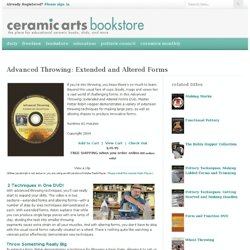
The techniques Robin describe aren’t difficult and provide many opportunities not only for bowls and mugs but also platters. For example, once you’ve mastered how to square a bowl, he then demonstrates how to square a sphere, which is much more challenging. But can you imagine the opportunities you’ll have when you can successfully square a pot? This may be all you need to get away from the usual round pots you’ve grown comfortable but bored with. Robin concludes the session by making a footed parabolic bottle that’s a sculptural form combining both the extending and altering techniques.
Ceramics. 121. Using Sodium Silicate and a Cheese Cutter to Create a Textured Vase with Hsin-Chuen Lin. Sculpting a bas relief Elephant Tile. SUMA "ConcreteJungle" Sculpting the Beetle Bas Relief.avi. Layers of Color. Artist statement I design and fabricate objects for domestic use.
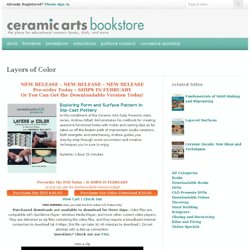
Through color, imagery, and form, I hope to create pots that are expressive and inviting. I am fascinated how we personalize and define ourselves through the objects we use and accumulate. The clothes we wear, the cars we drive, the things we decorate and furnish our homes with – all of these objects reflect our personality and aesthetic proclivities both publicly and privately. I am interested in the phenomenon of how we look and shop for objects. TRAILER THE SUCCESSOR OF KAKIEMON. Pottery Video of the Week: Making Clay Prototypes for Mold Making and Slipcasting. 113. Learning the Chattering Tips for Texturing the Pottery Surface with Hsin-Chuen Lin.
104.Glazing 3 Teapots with Hsin-Chuen Lin. Bas relief. Herend Porcelain Manufactory. How Its Made-Porcelain. Time-lapse bas-relief sculpture, Heidi Wastweet. Creating Curves with Clay. From Potter to Pottery Designer. 159. Glazing a Mug Using Mutiple Glazes with Hsin-Chuen Lin. Raku Firing: Advanced Techniques. Altering/glazing vase that was thrown on wheel. 11. Throwing and Altering a large vase with Hsin-Chuen Lin.
1. Throwing a Clay Pumpkin on the pottery wheel with Hsin-Chuen Lin. 22. Throwing / Altering a Vase & Inlay with Porcelain Rocks. 22. Throwing / Altering a Vase & Inlay with Porcelain Rocks. Pottery Video of the Week: How to Create Glaze Patterns with Latex Resist. Creating a Paper Stencil Part 2. 168. HPG Workshop Demo Part VIII ~ Trimming a Vase on the Chuck with Hsin-Chuen Lin. What If? Explorations with Texture and Soft Slabs. Creative Forming with Custom Texture. Getting Creative with Spouts & Handles. Herend Porcelain Manufactory. How to make a recycled glass dish. A Herendi Porcelánmanufaktúra 1. rész / The Herend Porcelain Manufactory Part 1.
Arts Céramiques quotidiennes - Les détails sur le papier autocollant pour Céramiques. There are three kinds of decal paper that can be used for just about any image: traditional, laser and Lazertran. All three types are applied using the water slide process, which consists of soaking the decal in water until it separates from the paper backing then sliding the image onto the surface (this will be demonstrated in Justin Rothshank’s video on Friday). The process varies with each type of decal paper.
Use the water-slide process to apply decals on already-fired glazed surfaces. Refire using the suggested temperature and firing schedule of the overglaze or china paint being used, usually Cone 023 – 018 depending on the color. Leave about 2 inches of space around and above the piece in the kiln to allow for fuming during firing. Traditional Decal PaperTraditional decal paper comes with a thin, gelatinous layer already on the paper, which appears as a shiny surface. These nonfiring, full-color decals are fairly durable with good image clarity.
Slabs, Templates, Texture, & Terra Sigilatta: Handbuilding and Surface Techniques. Jeremy Randall’s artist statement Familiarity evokes memory and I look to this association to present nostalgia through form.
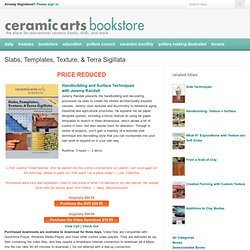
My reference to rural American architecture and antique rural implements places the viewer in a familiar setting which is layered with time, function and history while color creates celebration in these iconic objects. The vessel forms tie these objects back to the domestic space, enriching ones living environment while allowing for quiet contemplation and a reminder of a simpler time. The colors used refer to milk painted surfaces, layered and stained by generations of use and the elements and steel tacks are placed in the clay surface to give a direct connection to ideas of construction and joinery. The vessels relate to buckets, tool caddies, toolboxes, connecting the ritual of use back to the everyday, creating a connection to the importance of our most simple actions. Nerikomi -ドロシーの練り込み マジック Dorothy Feibleman's Nerikomi Magic part 2. 121. Using Sodium Silicate and a Cheese Cutter to Create a Textured Vase with Hsin-Chuen Lin.
Cp_nicolas_frize__instrumentarium=doc288.pdf. Video of the Week: How to Handbuild a Graceful Over-the-Top Teapot Handle That Looks Pulled - Boîte de réception - 'Yahoo! Mail' Arts Céramiques quotidiennes - Comment créer des motifs colorés avec du bordereau de transfert. Coat the sides, base, and handle while they are flat.

Start with a white low-fire slip so what is put on top becomes brighter. Apply an underglaze or wash over as a solid background color. Decorating the Surface On the surfaces of my pots I capture some of the qualities of the huipiles, which have a multitude of different patterns that work together visually. By situating regular slip-transferred patterns next to painterly marks, I emulate the contrast of the tight weave of fabric and hand-sewn decoration. With quick brush strokes, apply a deflocculated slip over the laser ink pattern. It is essential to layer the surface of a cup while the slab is still flat and wet. The underglaze or wash can be applied as a solid background color, a gradient, or a series of painterly strokes. All the pieces and parts of the cup are prepped, dry, and ready to assemble.
Then I print the inverse of the pattern using a laser printer on regular printer paper. Pottery Video of the Week: How to Make a Textured Soft Slab Wall Plate. How to Make Your Own Ceramic Mosaic Patio Table for Cookout Season - Boîte de réception - 'Yahoo! Mail' Tom Turner: Understanding Porcelain – Throwing and Decorating. About Tom Tom received his undergraduate degree in Art from Illinois State University in 1968.

He taught crafts while in the Army and then was asked to establish a ceramic art program for the College of Architecture at Clemson University. He did so in 1971 and taught there until 1976 when he resigned to work full time in his studio. He received his M.F.A at Clemson in 1973, moved to Florida in 1979, moved in 1982 to Medina, Ohio, moved to Delaware, Ohio in 1986 and moved to Mars Hill, North Carolina in 2005. He has worked with high fired porcelain for over 35 years. Wheel Throwing with Nan Rothwell.